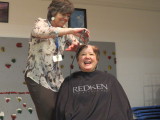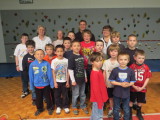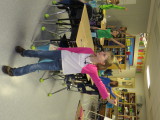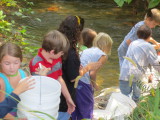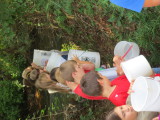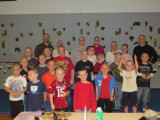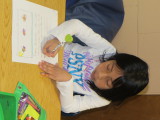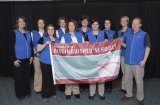-
Category 1
Selected in 2013
-
Grades: pre k - 5
School Setting: urban
Town Population: 11,000
Student Enrollment: 378
Student Demographics:
Black/African American: 1%
Teacher/Student Ratio: 1:20
White/Caucasian: 91%
Hispanic: 6%
Hawaiian/Pacific Islander: 0%
Asian: 1%
Native American: 1%
Other: 0%
% Reduced Lunch: 60%
% ELL Learners: 6%
Founded: 1986 -
PRINCIPAL:
Heather Hollingsworth -
CONTACT:
410 Hall Drive
Waynesville , NC 28785
828-926-3207
hhollingsworth@haywood.k12.nc.us
Jonathan Valley Elementary School
Waynesville , NC
The cards spark data conversations in grade level PLCs regarding individual students and assure we do not overlook any student’s needs. Charts of cards are used to identify needs, shape instruction, and track all students including those with disabilities, academically gifted, Pre-K, and economically disadvantaged.
- Describe specific programs in place to ensure that families are involved in the success of your school and students.
- Stakeholders provide input through Parent Advisory Councils, PTO, conferences, surveys, parent nights, and School Improvement Team. Opportunities for involvement include Doughnuts for Dads, Muffins for Moms, Reading Workshops, STEM Nights, Family Game Nights, Back to School Bash, Fall Festival, Grade Level Curriculum Nights, Meet the Teacher, Home Visits, Boo Hoo - Woo Hoo Party, Community Thanksgiving, Christmas Lunch, and our community Chess Tournament. Our Title I staff provides multiple opportunities throughout the year for parents to attend fun and engaging workshops with their children. Parents love to come to school to see their children perform and they also enjoy learning something with their child. In the upper grades, we like to invite parents to workshops in which the children teach them the different ways to solve problems or read passages. The more we can motivate students and parents to do educational things together, the more successful we will be as a school.
- Describe the most successful activity your school has initiated to strengthen ties to your community.
-
We could not be a Title I Distinguished School without our faithful and committed community partners. They infuse our school with numerous resources. We are a true community school and our stakeholders feel a great deal of ownership.
Although we have many events throughout the year that bring our school and community together, the single event that serves to strengthen those ties each year is our fall festival. Our PTO partners with businesses in the community to host an event that is fun for all ages. There are inflatables for the kids, live music for the older crowd, a silent and live auction for folks who enjoy that type of thing, and food vendors from all over town. The fall festival does not just draw our students and their parents, but also grandparents, aunts, uncles, and simply people who live and work in the community. The fall festival always sparks discussions about how some of the businesses and community leaders can help the school throughout the school year. - What are your school’s top two goals for the next year?
-
1. We plan to implement strategies that increase our students' volume of reading both at home and at school. The more a child reads the better reader he or she becomes. We tell the students all the time that "reading makes you smarter"!
2. As we go into the second year of the implementation of the Common Core and Essential Standards as well as the new tests, we want our students' growth and proficiency to increase. With the renorming of the tests this past year, we have a lot of work to do and a great deal of room for improvement. We want to see our proficiency percentages climb back into the 80's and 90's and we want to have a majority of our teachers who help students to exceed expected growth. - What is the single most important factor in the success of your school that others could replicate?
-
At Jonathan Valley Elementary School we track formative and summative assessment data for every student. A minimum of ten licensed professionals examine and review each student’s data. With that many folks looking at each student's data, it is almost impossible for a student to "fall between the cracks".
In our efforts to sustain and increase performance, we give students what they need. One way we use our data is to create targeted instruction based on formative assessment. We call this WIN time (“What I Need”). Teachers create grade level common assessments based upon instructional standards. Formative data from common assessments are used to drive instruction. Students are placed in small groups with teachers highly proficient in teaching identified skills. Common assessments are used to reassess skills. The “WIN” cycle is a continuous process. Student groups are fluid and change depending upon the grade level, strategy, skill assessed, and assessment data.
- Describe the program or initiative that has had the greatest positive effect on student achievement, including closing achievement or opportunity gaps, if applicable.
-
Research based instructional strategies are used to impact student achievement. These frameworks include Guided Reading, Comprehension Tool Kit, Reader’s Workshop, Units of Primary Writing, Shared Writing, Writers’ Workshop, and Math Investigations.
Guided Reading and Reader’s Workshop teach each student on an individual level. All increase performance and confidence in young students. Although we use these programs as frameworks for instruction, they are not what makes our school great. Our success is directly tied to the teachers and their passion for students.
Actively engaged students are high achievers who enjoy school. A wide variety of opportunities allow students to have fun and learn. A few of these include Farm to School, chess club, cooking club, and our 5th grade trip to Washington, DC. We provide motivation for students to read more through incentive programs. Our library is open weekly in the summer. Students who attend regularly are rewarded when school begins.
- Identify the critical professional development activities you use to improve teaching and student learning.
-
We attend high quality professional development (Dick Allington, Marcia Tate, Rick Wormeli, Richard and Rebecca DuFour, Roxanne Wilderman, and Doug Clements). Teachers participate in research based professional development such as Guided Reading, Strategies That Work, Comprehension Toolkit (K-5), Systematic Phonics Instruction, Writer’s Workshop, Units of Primary Writing, Math Partners, Investigations, Writing Across the Curriculum, Continuum of Literacy Learning, Reading Foundations, Math Foundations, LLI Training, AIMS, and STEM Design Training.
Guided Reading and Comprehension Toolkit professional development has helped teachers transition from whole group instruction to small group and individualized instruction.
Professional development with Math Partners and Math Foundations focuses on problem solving strategies and helping students learn to solve problems in multiple ways. - Describe how data is used to improve student achievement and inform decision making.
-
To identify needs in reading and math, we use EOG data for 3-5 students and K-2 assessment data. Data for kindergarten students is obtained prior to the beginning of school using the Brigance assessment and a home visit with the families. Kindergarten students receive targeted help beginning the first full week of school.
The Title I prioritized academic needs assessment takes growth and proficiency into account to determine differentiation and interventions.
Using collected data, teachers create color-coded cards, one for each student. Specific data are recorded and updated continuously throughout the year. The cards spark data conversations in grade level PLCs regarding individual students and assure we do not overlook any student’s needs. Charts of cards are used to identify needs, shape instruction, and track all students including those with disabilities, academically gifted, Pre-K, and economically disadvantaged.
Stats
-
Category 1
Selected in 2013
-
Grades: pre k - 5
School Setting: urban
Town Population: 11,000
Student Enrollment: 378
Student Demographics:
Black/African American: 1%
Teacher/Student Ratio: 1:20
White/Caucasian: 91%
Hispanic: 6%
Hawaiian/Pacific Islander: 0%
Asian: 1%
Native American: 1%
Other: 0%
% Reduced Lunch: 60%
% ELL Learners: 6%
Founded: 1986 -
PRINCIPAL:
Heather Hollingsworth -
CONTACT:
410 Hall Drive
Waynesville , NC 28785
828-926-3207
hhollingsworth@haywood.k12.nc.us


